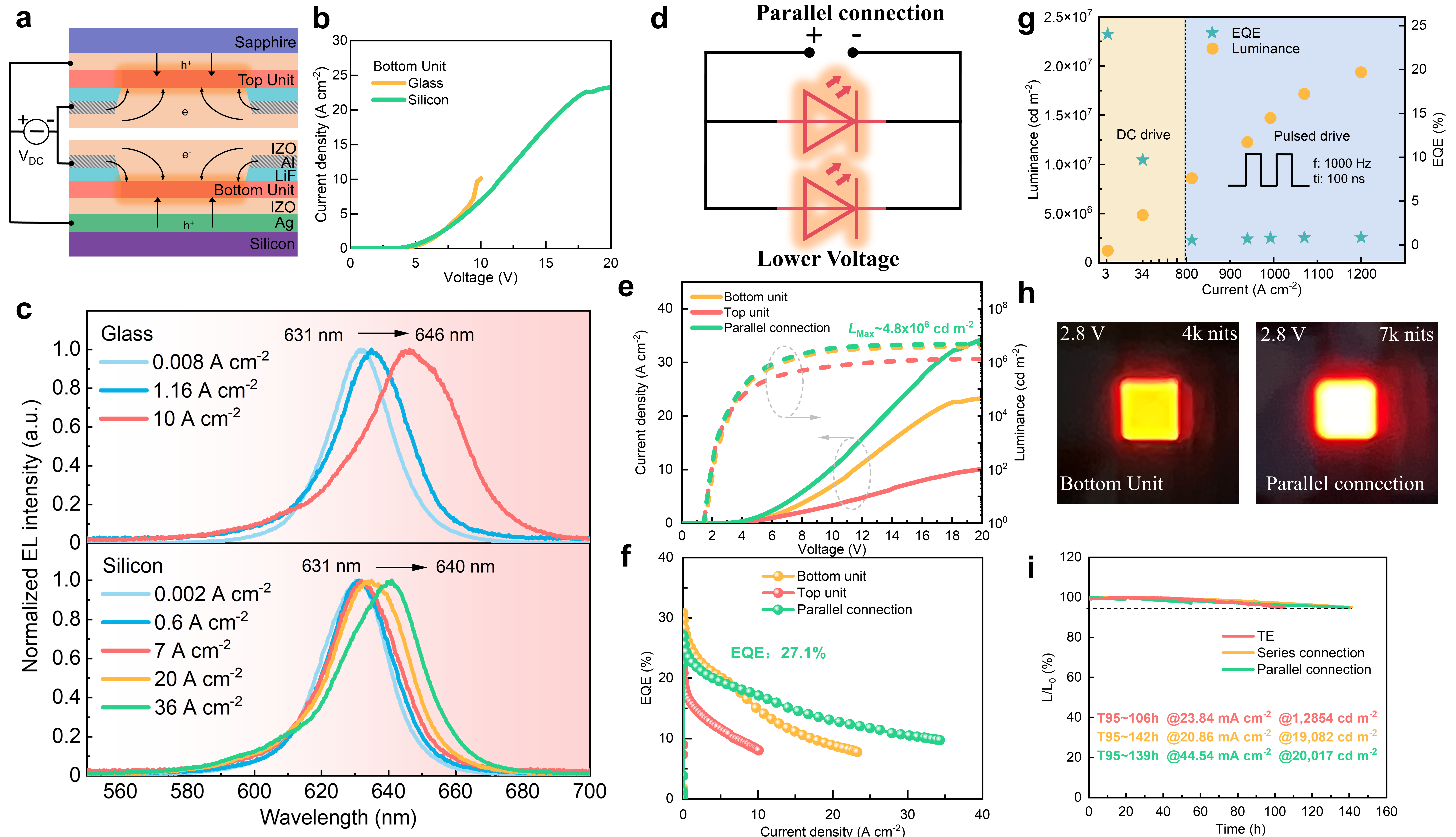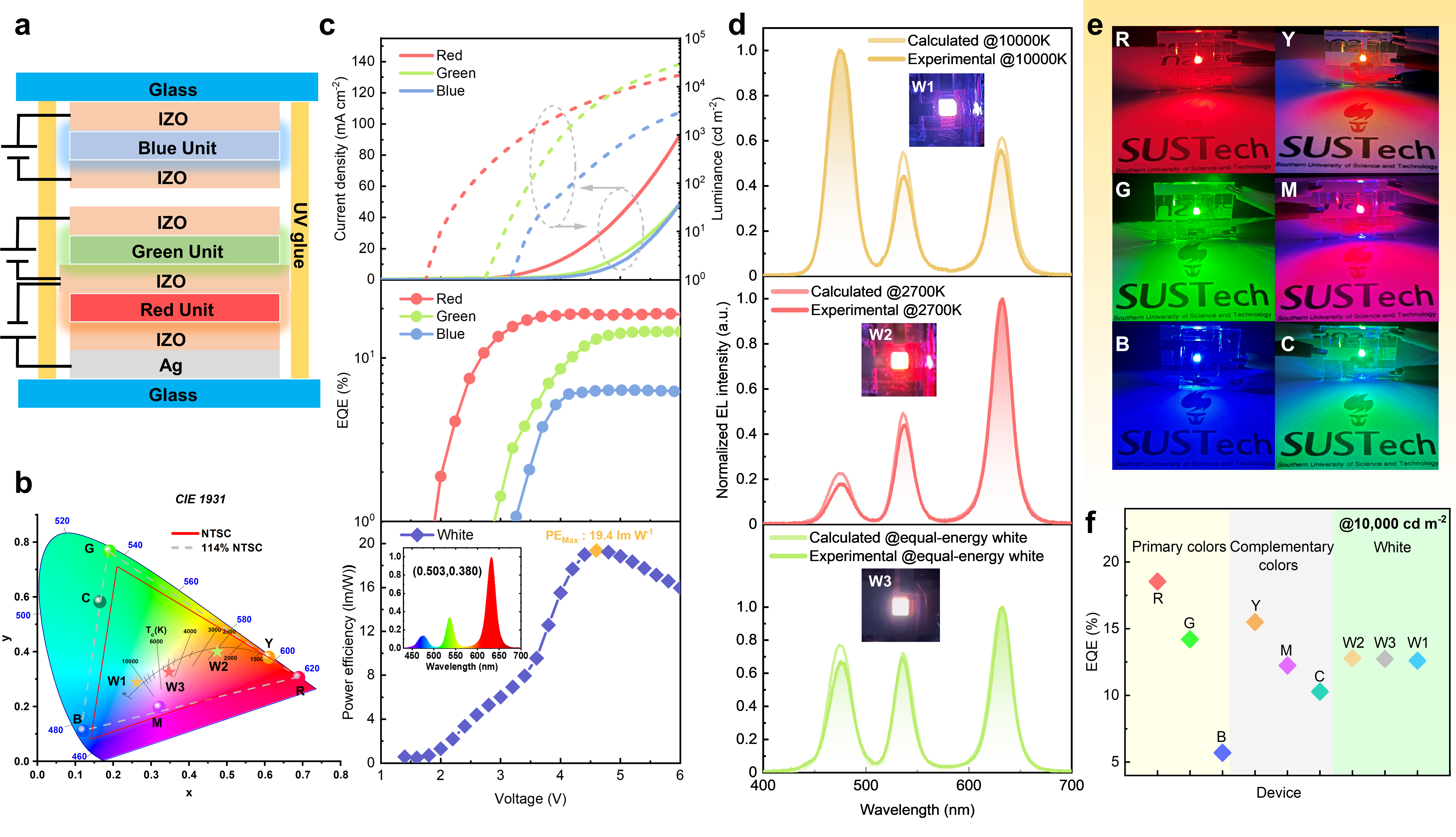The tandem architecture of quantum-dot light-emitting diodes (QLEDs), achieved through vertical integration of n light-emitting units, can theoretically improve the comprehensive device performance to n-fold that of single-unit, thereby presenting revolutionary opportunities for ultra-high-definition display technologies and solid-state lighting applications. However, tandem QLEDs fabricated via traditional solution processing have long faced three major technical barriers: Inefficient charge injection caused by energy level mismatch in intermediate interconnecting layers, leading to performance limitations. Interlayer mixing induced by the failure of solvent orthogonality, disrupting layer integrity. Additionally, structural damage from multiple annealing processes compromises both performance enhancement and long-term stability. These challenges have collectively imposed significant constraints on the advancement of tandem QLED technology.

To address this industry challenge, Professor Shuming Chen’s group from the Department of Electronic and Electrical Engineering at the Southern University of Science and Technology (SUSTech) has innovatively proposed a “face-to-face integrated” tandem device architecture. This solution employs a breakthrough discrete fabrication process, where the optical efficiency characteristics and charge transport properties of the top-emitting and transparent units are independently optimized. Precise alignment is then used to achieve spatial coupling between the two light-emitting units, enabling synergistic device integration. This architecture not only supports three operational modes—series, parallel, and full-color tunable—but also achieves record-high efficiency in high-brightness tandem QLEDs.
Their paper, titled “Face-to-face integrated tandem quantum-dot LEDs with high performance and multifunctionality”, has been published in Light: Science & Applications, a leading international optical journal.
The research team conducted a systematic comparative analysis of light outcoupling efficiency (OCE) between conventional tandem QLEDs and face-to-face integrated tandem QLEDs through optical simulations (Figure 1). A detailed device architecture of the tandem QLED was established to optimize performance (Figure 1g). They implemented a sophisticated optical microcavity design to minimize optical losses, enabling the bottom and top units to exhibit ultrahigh reflectance and transmittance of over 95% at 630 nm. Through rigorous calculations and experimental validation, this face-to-face integrated tandem QLED achieved an OCE of 75.9%, demonstrating comparable performance to conventional tandem devices at 77.2%.
The two units of this structure can be simultaneously fabricated, which shortens the manufacturing process and eliminates the issue of solvent-induced erosion of underlying thin films in conventional tandem structures. Concurrently, the mutual encapsulation between the two units avoids introducing additional optical components that would otherwise cause optical losses.

Figure 1. Optical performance analysis of face-to-face integrated tandem QLED
When operating in series mode, the J-V-L (current density-voltage-luminance) characteristics reveal that the turn-on voltage (VT) of this tandem QLED reaches 3.3 V, approaching the sum of VT of both top and bottom units, indicating the realization of superior electrical interconnection. At equivalent current density, the tandem QLED exhibits significantly enhanced luminance compared to control devices. Consequently, the external quantum efficiency (EQE) of the tandem QLED demonstrates a remarkable improvement, achieving a record-high value of 60.7%.
A comparative analysis of key performance metrics between the tandem QLED developed in this study and previously reported devices highlights its outstanding efficiency and brightness (Figure 2f). The results conclusively demonstrate that this face-to-face integrated tandem QLED exhibits the most superior performance metrics among state-of-the-art tandem QLEDs.

Figure 2. Performance of tandem QLED in series mode
The researchers investigated the potential of face-to-face integrated QLEDs to achieve ultra-high luminance. By employing silicon and sapphire substrates with higher thermal conductivity for the bottom and top units, respectively, they effectively minimized internal heat accumulation, ensuring stable device operation under high current densities. Furthermore, the incorporation of metal auxiliary electrodes reduced voltage loss across the lines. In parallel mode, the tandem QLED demonstrated operational capabilities at 20 V bias voltage and current densities exceeding 35 A/cm², ultimately achieving a luminance surpassing 4.8×106 cd/m².
To further optimize device performance, the team implemented a customized pulsed power supply, allowing enhanced heat dissipation during pulse intervals. Under pulsed driving conditions at 1 kHz frequency with 100 ns pulse width, the device exhibited instantaneous luminance exceeding 107 cd/m² at peak current densities over 1200 A/cm², accompanied by a fluence of 1.66 uJ/cm2 per pulse. These results demonstrate the device’s promising potential as an optical pumping source for advanced photonic applications.

Figure 3. Performance of tandem QLED in parallel mode
They demonstrated vertically stacked full-color tunable QLED devices, with the specific architecture integrating a blue top unit, a red conventional QLED bottom unit, and a green inverted QLED, forming a trichromatic (RGB) vertical integration configuration (Figure 4a). The core advantage of this design lies in the independent driving control of electroluminescent behaviors for each emission sub-unit, enabling precise regulation of chromaticity, luminance, and correlated color temperature (CCT), ultimately achieving a color gamut coverage of 114% NTSC. To realize the desired color coordinates and specified brightness, the team employed colorimetry-based light intensity ratio inversion calculations to determine the required luminance levels for individual sub-pixels. Corresponding DC voltage driving conditions were then optimized for each RGB emission unit accordingly.
The resulting white light spectrum exhibited excellent agreement with theoretical predictions (Figure 4d), validating the reliability of this modulation methodology. A demonstration video of the full-color tunable QLED (provided below) showcases its capabilities. This architecture offers significant advantages in achieving high-quality adjustable illumination, establishing a solid foundation for diverse application scenarios, including intelligent indoor lighting and ambient light control systems.

Figure 4. Realization of full-color tunable QLEDs
Movie 1. Demonstration of full-color tunable QLEDs
This study proposes a simple yet efficient methodology that provides a novel approach for realizing high-performance tandem QLEDs. Owing to its outstanding performance and versatile properties, this method is anticipated to accelerate the application of QLED technology in the lighting industry, while further expanding its application potential in emerging domains such as advanced photodynamic therapy, optical pumping excitation, and other advanced technological fields.
The first author of the paper is Ph.D. candidate Haotao Li at SUSTech. Ph.D. candidate Jiming Wang at SUSTech also contributed to this work. Professor Shuming Chen is the corresponding author, with SUSTech serving as the primary affiliated institution.
Paper link: https://www.nature.com/articles/s41377-025-01835-9
To read all stories about SUSTech science, subscribe to the monthly SUSTech Newsletter.
Proofread ByAdrian Cremin, Yuwen ZENG
Photo ByDepartment of Electronic and Electrical Engineering